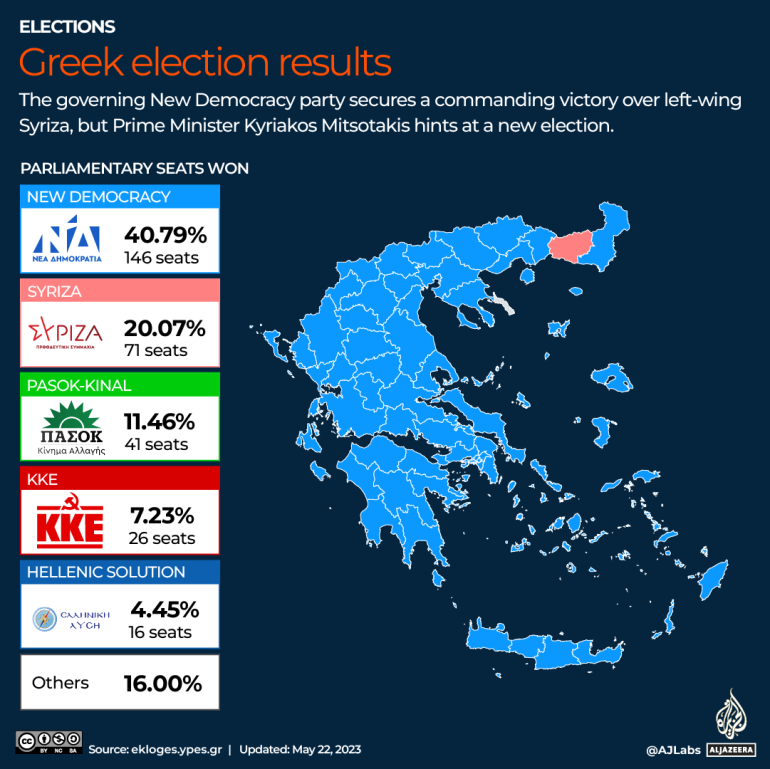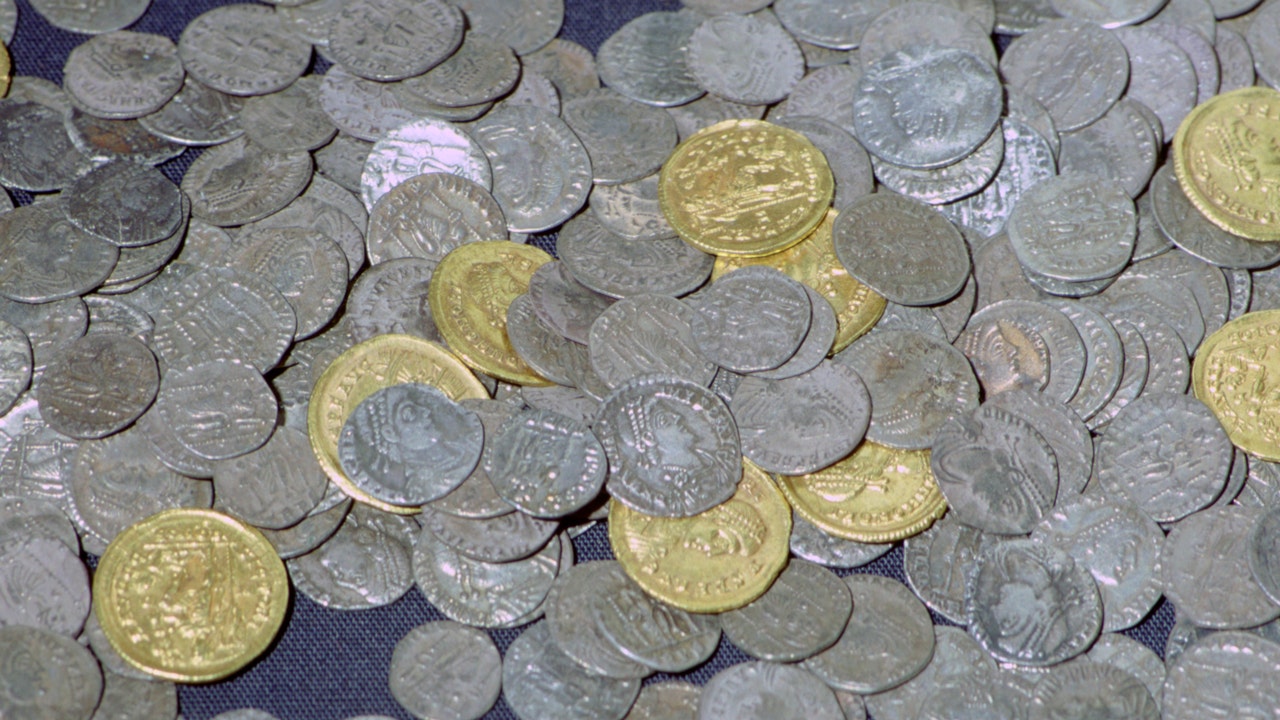World
Greek conservatives clear an ‘open road’ to political supremacy

Athens, Greece – Greek Prime Minister Kyriakos Mitsotakis says he will not try to form a government after his party won the general election by a huge margin.
“I don’t believe there’s any basis for the formation of a government in this parliament,” the leader of the conservative New Democracy party told President Katerina Skellaropoulou on Monday after she gave him the order to do so.
Mitsotakis is expecting to be in an even better position after a second vote, which could take place as early as next month.
In Sunday’s election, New Democracy finished first with 40.8 percent of the popular vote, a percentage point more than in the previous national polls four years earlier and about 20 points ahead of the second-placed party, the left-wing Syriza.
The vote took place under a system of proportional representation, legislated by Syriza before it fell from power in 2019.
Under that system, Mitsotakis’s ruling party fell five seats shy of the 151 seats in the 300-seat legislative chamber needed to govern again.
New Democracy has passed a new electoral law, which restores seat bonuses to the winning party. But under the constitution, changes to electoral law can only take effect in the second election after the legislative change, so no party can game the system to remain in power indefinitely.
“If the electoral system were in force yesterday that will apply in the next election, New Democracy would have a strong majority of more than 170 seats, so I feel it is my duty to help us move beyond the obstacle, as it turns out to be, of proportional representation,” Mitsotakis said.
He said he would return the order to form a government to Sakellaropoulou within the day.
Procedurally, she must then ask Syriza, which won 20 percent of the vote, to form a government and, finally, the socialist PASOK-Movement for Change (PASOK-KINAL), which garnered 11.5 percent.
If these parties exhaust the three-day opportunity to form a government, the run-off would happen as soon as June 25.
It is a sign of Mitsotakis’s confidence that he decided to pass up the opportunity to form a coalition government, preferring to discredit proportional representation, a cause célèbre of the left.
On Sunday night, he hailed New Democracy’s resounding victory as a “political earthquake” and said the election result “surpassed even our expectations”.
Polls had predicted that New Democracy would win 32 to 35 percent of the vote, and even a joint exit poll put the centre-right party no more than 10 points ahead of Syriza. The result suggests New Democracy will handily win the rematch.
“New Democracy managed to persuade people that they are efficient and effective, and [left-wing leader Alexis] Tsipras and Syriza failed to present a credible alternative,” journalist and seasoned political commentator Panos Polyzoidis told Al Jazeera.
Mitsotakis’s party had promised to relaunch the Greek economy, but the COVID-19 pandemic, a refugee crisis with Turkey and energy inflation stemming from the Ukraine war sapped much of the government’s executive vigour.
Still, it did manage to lower business and personal income taxes, reduce unemployment, balance the budget and increase foreign investment.
Mitsotakis now promises to “move much faster and with greater boldness to implement our electoral commitments”.
Those include boosting exports, raising salaries and cutting more taxes.

What about the opposition?
Syriza’s precipitous fall from more than 31 percent of the popular vote four years ago has led many to predict its demise as a political force.
“The disappointment is that there’s no opposition now,” said Lefteris Dragomanidis, a Syriza voter who owns a stand at a farmers market in Athens. “I think in the next election, Syriza will go back to where it was before, and KINAL will rise. We all know that Syriza’s voters were formerly KINAL.”
A decade ago, during the global financial crisis, Greece’s ruling socialists cut government spending radically to tame the country’s massive deficit. As austerity led many socialist voters into unemployment and poverty, Syriza welcomed them.
When the Panhellenic Socialist Movement, or PASOK, came to power with 44 percent of the popular vote in 2009, Syriza barely cleared a 3 percent threshold to enter parliament, winning 4.6 percent.
Over six years, they traded places. Syriza came to power in 2015 with a transfusion of PASOK supporters, winning 36 percent of the vote. PASOK fell to 4.7 percent and renamed itself Movement for Change, or KINAL.
KINAL’s performance under new leader Nikos Androulakis is a 50 percent increase on its 2019 showing. “I thank all the Greeks for tonight’s great victory, for co-signing on the rebirth of PASOK,” the 44-year-old said on election night.

“The Syriza project has failed, and that means PASOK is back in pole position to lead that centre left,” Polyzoidis said.
“That’s going to take years. I don’t expect them to recover anytime soon. So Mitsotakis will have an open road for several years to come,” he added.
“We know that Tsipras was hoping to turn Syriza into the main party of the centre left,” the commentator said. “He definitely failed to do so because Syriza remains a plethora of different shades of left and centre left without a clear identity.”
Syriza, too, was eventually burned by the fire of austerity. Before taking office eight years ago, the party had promised to rip up Greece’s emergency loan agreements with creditors that bailed out the Greek state, only later to sign onto one itself.
But it also suffered a spectacular series of own goals.
Tsipras was unable to cleanse Syriza of what its opponents call the “loony left” when he failed to curtail the influence of former Health Minister Pavlos Polakis, a die-hard populist.
Days before the elections, Tsipras had to dismiss shadow Foreign Minister Yiorgos Katrougalos after he said Syriza should more heavily tax the self-employed – a million-strong cohort. Pollsters found that 9 percent of them switched to New Democracy on election day.
Also before the vote, police in the central town of Karditsa caught five Syriza operatives in a car with about 200 personal identity cards, envelopes stuffed with cash and ballots marked to support a local candidate of the party.
Syriza lost support not only to KINAL but also to the Communist Party of Greece, which went from 5.3 percent to 7.2 percent of the vote.
There was a huge difference in style between the top two parties.
New Democracy set out macroeconomic targets for growth, jobs, exports and the national debt. Syriza promised across-the-board pay increases without saying how these would be paid for and seemed to have no overall vision of its national economic goals.
“[Tsipras] campaigned on the basis of what was wrong with New Democracy, not what he was going to do for people,” said Dragomanidis’s assistant at the farmers market. “He was painting everything black.”

World
The history of the Hoxne Hoard, the largest collection of Roman treasure found in Britain

The Hoxne Hoard is one of Britain’s unique archaeological finds, not just by its value, but also by how it was found.
Various sources note the Hoxne Hoard as the largest hoard of Roman treasure ever found in Britain. The collection of treasures is heavily made up of gold and silver coins, though there are other objects, such as tableware and jewelry that were also found.
How this collection of ancient treasures was found adds to its uniqueness.
The Hoxne Hoard is primarily made up of coins. (CM Dixon/Print Collector/Getty Images)
SANXINGDUI RUINS WERE DISCOVERED ACCIDENTALLY BY A FARMER; HAS SINCE BEEN THE SITE OF OVER 60K RELICS
On Nov. 16, 1992, Eric Lawes was scouring a field in Hoxne village in Suffolk, not on the hunt for hidden treasure, but simply looking for a hammer that had been lost on the land.
Lawes was scanning the area with his metal detector, when he came across a small portion of the treasures within what would become the Hoxne Hoard.
After shoveling up some of the silver spoons and gold coins he found, he quickly reported his find to be properly excavated.
Lawes was awarded £1.75 million for his find, which he shared with the farmer who owned the land the treasures were discovered on, according to the Smithsonian Magazine.

While looking for a lost hammer with a metal detector, a man came across a find far bigger. This discovery later became known as the Hoxne Hoard. (iStock)
THE 4,000 ITEMS IN THE STAFFORDSHIRE HOARD MAKE IT THE LARGEST COLLECTION IN HISTORY OF ITS KIND
The very next day, the Suffolk County Council Archaeology Service (SCCAS) was on the scene, according to the World History Encyclopedia.
The gold and silver artifacts part of the Hoxne Hoard weigh around 60 pounds in total, according to Ancient Origins. There are around 15,000 Roman coins as part of the collection, per The British Museum, where many of the items are displayed today. The items were buried in the 5th century A.D.
Other unique finds include pieces of jewelry, like a body chain, six necklaces, three finger rings and gold bracelets, according to the source.

There were many pieces of jewelry found as part of the Hoxne Hoard, including gold bracelets. (CM Dixon/Print Collector/Getty Images)
MOM, SON DIG UP ANCIENT OBJECT OFTEN FOUND NEAR BURIAL GROUNDS WHILE GARDENING
Even though the Hoxne Hoard is heavily made up of coins, one of the best-known treasures that was found was the “Empress” pepper pot. This pot was one of four that were excavated from the site, according to The British Museum. The pepper pot is intricately formed to represent a woman.
Additionally, there were many tableware items that were part of the hoard, including a set of 19 spoons, in good condition, that were decorated with marine themes, according to The British Museum.
Archaeologists believe that the Hoxne Hoard was buried no later than 450 A.D., according to Ancient Origins.
At the end of the 4th century A.D., the western Roman Empire was in a place of uncertainty, with Roman soldiers exiting Britain, leaving citizens to fend for themselves.

One of the significant finds of the Hoxne Hoard is the pepper pot pictured above. (CM Dixon/Print Collector/Getty Images)
While experts have posed varying hypotheses as to why the hoard was buried, one common suggestion is that it was done for protection, with the intent of the owners collecting their precious items once again. In the case of the Hoxne Hoard, the items were never retrieved by their owners.
Today, the Hoxne Hoard is on display at the British Museum in London. The display contains many of the coins, jewelry and tableware, as well as Lawes’ hammer, which he was originally looking for when he stumbled upon the far more significant discovery.
World
Greece confronts disastrously low birth rate in Aegean Islands

At 1.3 babies per woman, Greece’s fertility rate is among Europe’s lowest — and well below the threshold for population growth.
Authorities in the Aegean Islands have warned that low birth rates spell disaster for their region.
Mayors from the islands expressed serious concerns during the 15th Congress of Small Islands in Milos, where they lamented the continuous downward trend of Greece’s births-to-deaths ratio and said the consequences were already visible in their communities.
A case in point is Agios Efstratios, a small island in the north Aegean with no more than 250 inhabitants.
‘’There are no girls on the island. Or at least there are no more than 2 women under 30 years old,” said Kostas Sinanis, the local mayor.
“The same goes for the boys. We need to search for the incentives that will bring the young boys and girls back to the island, the place where they were born and raised, to create their families. Unfortunately, we had one birth last year and another one three years ago.”
In 2022, Greece recorded its lowest number of births in 92 years — and this year, the country posted the second-largest population decrease in the EU.
Greece’s fertility rate is among the continent’s lowest at 1.3 babies per woman, well below the 2.5 needed for population growth. Economic forecasts indicate its workforce will fall by 50% by 2100, with its output shrinking by 31% over the same period.
Michalis Vlastarakis of the Eurobank Group warned that if nothing is done, disaster will follow.
‘’If we don’t do something, in about 25 years from now, in two decades, one-third of the population will be over 65 years old, and in 2050 we will be 2.5 million less”, said Vlastakaris.
“You don’t need to have studied finance to understand the consequences of these projections on economic indicators, GDP, the workforce, the insurance system, pensions, health, and education, even since there’re going to be fewer schools.’’
Greece’s family ministry said a few days ago that it plans to spend €20 billion through 2035 on incentives to halt the decline, including cash benefits and tax breaks.
The government already spends around €1 billion a year on pro-child measures — but like other European countries doing the same, it has seen little impact.
World
Jon Batiste's 'Beethoven Blues' transforms classical works into unique blues and gospel renditions
NEW YORK (AP) — When Grammy-award winner Jon Batiste was a kid, say, 9 or 10 years old, he moved between musical worlds — participating in local, classical piano competitions by day, then “gigging in night haunts in the heart of New Orleans.”
Free from the rigidity of genre, but also a dedicated student of it, his tastes wove into one another. He’d find himself transforming canonized classical works into blues or gospel songs, injecting them with the style-agnostic soulfulness he’s become known for. On Nov. 15, Batiste will release his first ever album of solo piano work, a collection of similar compositions.
Titled “Beethoven Blues (Batiste Piano Series, Vol. 1),” across 11 tracks, Batiste collaborates, in a way, with Beethoven, reimagining the German pianist’s instantly recognizable works into something fluid, extending across musical histories. Kicking off with the lead single “Für Elise-Batiste,” with its simple intro known the world over as one of the first pieces of music beginners learn on piano, he morphs the song into ebullient blues.
“My private practice has always been kind of in reverence to, of course, but also to demystify the mythology around these composers,” he told The Associated Press in an interview ahead of Wednesday’s album release announcement.
The album was written through a process called “spontaneous composition,” which he views as a lost art in classical music. It’s extemporization; Batiste sits at the piano and interpolates Beethoven’s masterpieces to make them his own.
“The approach is to think about, if I were both in conversation with Beethoven, but also if Beethoven himself were here today, and he was sitting at the piano, what would the approach be?” he explained. “And blending both, you know, my approach to artistry and creativity and what my imagined approach of how a contemporary Beethoven would approach these works.”
There is a division, he said, in a popular understanding of music where “pristine and preserved and European” genres are viewed as more valuable than “something that’s Black and sweaty and improvisational.” This album, like most of his work, disrupts the assumption.
Contrary to what many might think, Batiste said that Beethoven’s rhythms are African. “On a basic technical level, he’s doing the thing that African music ingenuity brought to the world, which is he’s playing in both a two meter and a three meter at once, almost all the time. He’s playing in two different time signatures at once, almost exclusively,” he said.
Batiste performs during the Bonnaroo Music & Arts Festival this year. (Photo by Amy Harris/Invision/AP, File)
“When you hear a drum circle, you know, the African diasporic tradition of playing in time together, you’re hearing multiple different meters happening at once,” he continued. “In general, he’s layering all of the practice of classical music and symphonic music with this deeply African rhythmic practice, so it’s sophisticated.”
“Beethoven Blues” honors that complexity. “I’m deeply repelled by the classism and the culture system that we’ve set up that degrades some and elevates others. And ultimately the main thing that I’m drawn in by is how excellence transcends race,” he said.
When these songs are performed live, given their spontaneous nature, they will never sound exactly like they do on record, and no two sets will be the same. “If you were to come and see me perform these works 10 times in a row, you’d hear not only a new version of Beethoven, but you would also get a completely new concert of Beethoven,” he said.
“Beethoven Blues” is the first in a piano series — just how many will there be, and over what time frame, and what they will look like? Well, he’s keeping his options open.
“The themes of the piano series are going to be based on, you know, whatever is timely for me in that moment of my development, whatever I’m exploring in terms of my artistry. It could be another series based on a composer,” he said.
“Or it could be something completely different.”
-
/cdn.vox-cdn.com/uploads/chorus_asset/file/25439572/VRG_TEC_Textless.jpg)
/cdn.vox-cdn.com/uploads/chorus_asset/file/25439572/VRG_TEC_Textless.jpg) Technology7 days ago
Technology7 days agoCharter will offer Peacock for free with some cable subscriptions next year
-

 World6 days ago
World6 days agoUkrainian stronghold Vuhledar falls to Russian offensive after two years of bombardment
-

 World6 days ago
World6 days agoWikiLeaks’ Julian Assange says he pleaded ‘guilty to journalism’ in order to be freed
-

 Technology6 days ago
Technology6 days agoBeware of fraudsters posing as government officials trying to steal your cash
-

 Health4 days ago
Health4 days agoHealth, happiness and helping others are vital parts of free and responsible society, Founding Fathers taught
-

 Virginia1 week ago
Virginia1 week agoStatus for Daniels and Green still uncertain for this week against Virginia Tech; Reuben done for season
-

 Sports5 days ago
Sports5 days agoFreddie Freeman says his ankle sprain is worst injury he's ever tried to play through
-

 News4 days ago
News4 days agoLebanon says 50 medics killed in past three days as Israel extends its bombardment








/cdn.vox-cdn.com/uploads/chorus_asset/file/22259288/Apple_dan_riccio_begins_a_new_chapter_at_apple_01252020_big.jpg.large_2x.jpg)








